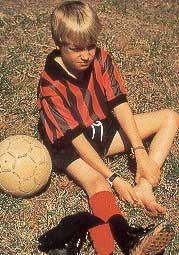Osgood Schlatters Disease Frequently Asked Questions
On average patients who follow the Strickland Protocol for Osgood Schlatters Disease will have to rest from sport for 3 weeks. Some may take longer because their injury is more severe, or because they don’t follow the protocol strictly!
(they usually cheat by playing some sports, or by accident – they kick a football around during lunchtime not realising REST means TOTAL REST). However some patients respond even quicker and I have had some that have returned to sport within 7-14 days. Remember 20 days is the average-that means some return earlier and some later than that.
Not following the Strickland Protocol means your child will suffer from the condition on average about 21 months, usually in episodes depending on levels of activity and growth rates. Again some will suffer for a shorter time and some longer.The longest sufferer I had a patient who had the disease Osgood Schlatters for over 3 years and even he responded to our treatment. If in doubt please do get in touch by using the email lower down this page.
SEVERS DISEASE
Can this treatment sure Severs? Yes it can. But there are some modifications required to the treatment and testing as it is a similar condition but in a different location-
1. HOW LONG WILL I NOT BE ABLE TO PLAY SPORT
Sever’s disease, affecting the heel, is a growth conditions affecting young athletes. Another is Sindig-
It is possible to have more than one condition-
However it is relatively common to get one condition affecting both legs. It depends on the loading e.g. sprinters and gymnasts tend to use both legs equally so often have the condition bilaterally; whereas footballers tend to have one side dominate and thus often have only one leg affected.
2. AM I LIKELY TO GET IT ANYWHERE ELSE?
The standard current treatment advice is –
When this happens the lump can get bigger and bigger and the soft cartilage starts to change to bone making the lump permanent. This will have future implications as 60% of patients with these lumps will have pain whenever they kneel for the rest of their lives.
A small percentage of chronic sufferers may need surgery to remove bony splinters or ossicles from the front of their knees.
Eventually though the symptoms of pain on activity will go as they finish their growth spurt.
So if you do nothing it WILL go –
4. IS IT LIKELY TO OCCUR AGAIN?
Yes it can come back. Usually if the child has another rapid growth spurt and continues to play high volumes of sport, without stretching.
Keeping up with the stretches as recommended should prevent it from recurring.
However if it does recur, following the Strickland protocol again as treatment, it will resolve it in an even shorter time.
6. WHAT IF I HAVE ANOTHER QUESTION?
Please send any additional questions you may have to physio@proact-
We will respond to every question as soon as possible. Also visit our Osgood Schlatters facebook page which we update regularly

